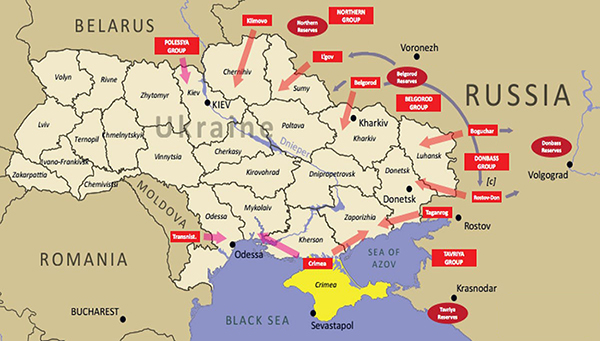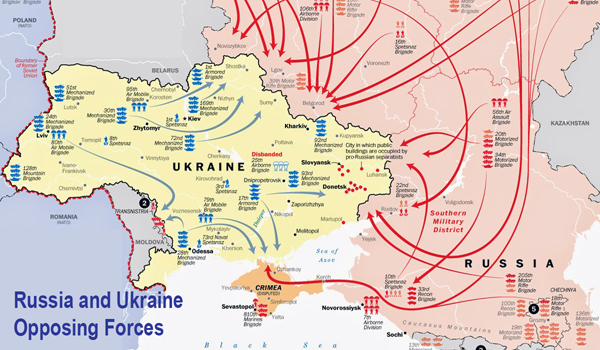Analysis of Precedents
If Putin decides to go to war what options does he have? To empirically analyse these options let us take a look at past precedents – namely the invasion of Georgia in 2008 and the capture of Crimea in 2014.
Georgia 2008. The CIA had started its series of colour revolutions In Eastern Europe to spread democracy. Under that pretext anti-Russian regimes were being installed on the Russian borders. Putin was elected in Russia in year 1999. In 2003, a pro-West President Shaakashvilli took power in Georgia. Georgian territory posed serious threat to Russian Muslim underbelly of Chechenya. In April 2008, at the Bucharest Summit, it was announced that NATO would welcome inclusion of Georgia and Ukraine. This was a clear Russian red line. Russia began massing troops on the borders of Georgia. It encouraged Russian separatists in Abkhazia and Ossetia to intensify their actions. Russian separatists in Osettia began to shell Georgian villages. Georgia now made the mistake of launching ground assaults in Osettia and captured the separatist stronghold of Takshanvali. This was the precise pretext the Russians were looking for. Their troops were in position and, on 8 August, they launched a massive counterattack. It began with a major cyber attack and electronic warfare operations to jam communications. The Russian 58th Army attacked across the mountains via the Roki tunnel and cleared all of Osettia and took some more territory ahead. Concurrently, the Russian Black Sea fleet blockaded the coast of Georgia and Russian troops made amphibious landings in Abkhazia. They quickly moved inland and cleared the whole of Abhkazia. They moved beyond that province and seized the cities of Zugdidi, Senaki, Poti and Gori. By 12th August, it was all over and the French negotiated a ceasefire. Russia recognized Osettia and Abhkazia as independent states. They vacated all other Georgian territory. This was the first war in Europe in the 21st century.
Ukraine 2014 – The Capture of Crimea. US persisted with its colour revolutions. In February 2014, as part of the Orange Revolution the pro-Russian President Yankovich of Ukraine was deposed and fled to Russia. His successor once again began to talk of joining NATO. Russia saw a clear violation of its red line in Ukraine. Russian forces were already in the leased naval base of Sevastapole. On 28 February, Russian troops moved in swiftly and occupied the whole of Crimea without a shot being fired. They held a referendum and, by 18 March, had simply incorporated Crimea into Russia. Concurrently, they backed Russian separatists in Donbas region and instigated revolts in the Oblasts of Dontsk and Luhansk. A number of Russian troops in civil clothes but with heavy weapons also moved into these rebel provinces, almost like a repeat of Georgia. What was noteworthy was the speed and decisive nature of this operation. Russia had clearly asserted its red lines in Ukraine and enforced them in a swift coup de main operation. The US and NATO could do nothing.
The Current Crisis
The current crisis stems from Putin’s determination to make the altered military realities count on ground in Europe. As Prof Meershimer says, Putin is seeking to change the entire post Cold War security architecture in Europe and enforce a Monroe doctrine variant. He is seeking written guarantees for non-inclusion of Ukraine in NATO and assurances about non-stationing of offensive weapons in the countries drafted into NATOin the last two decades. Towards this end, he has forward deployed some 1,90,000 troops around Ukraine. Next, he went ahead and recognized the breakaway provinces of Dontesk and Luhansk in a clear escalatory move that underlines his determination. But, were Dontesk and Luhansk his red lines? What are his military options in case diplomacy fails to deliver on what he had demanded? US and NATO have already refused to give written assurances and asserted that Ukraine as a sovereign state has the right to choose its form of government and what treaties it will join.
This amounts to a deadlock and, if talks break down, what will a military invasion of Ukraine look like? There are primarily three options:-
Georgia Redux. The Ukraine scenario today is remarkably similar to the situation in Georgia in 2008. Like Abkhazia and Osetta, the two Russian speaking states of Dontesk and Luhansk have separatists in full scale revolt. Russia has also sent in its troops in muftis inside. Firing incidents have started on the borders of these two provinces. Russia has already recognized their independence and troops have started moving in. In this option Russian troops would move beyond the Line of Contact to the border of these provinces. So a Georgian redux style operation could see occupation of and escalation in these two districts . While troops from Donbas are engaging Ukranian troops on the border frontally, Russian forces from Crimea would hit them in the rear. This would consolidate occupation of these two provinces and certain other territories to give tactical depth to these states.
Limited War Option. What next will depend on what Ukraine does militarily. Any military response would provide the pretext/justification of what would follow next. There are two option limited war or full scale offensive. Limited war would see Russian forces from the East making a dash for Kharkiev (former capital of Ukraine). Forces from Crimea would advance upon the port city of Mariopole. Naval landings could be mounted to seize the port city of Odessa. Thus, Ukraine would be cut off from the sea and become a landlocked country dependant on Russia. This option entails fighting in built-up areas to secure cities and capturing and holding ground. This can cause heavy casualties and take a lot of time as cities can be defended street by street.
Fullscale War Option. Prof Meershimer, noted political scientist of the University of Chicago, feels that Russia will not aim to seize and defend territory in Ukraine (as it could get bogged down in an Afghanistan like quagmire). The Russian aim would be simply to wreck Ukraine as a functional state. Towards this end, this could unfold with massive cyber attacks and electronic warfare strikes to paralyse communications. The Russians would rapidly gain air and naval supremacy and commence operations with massive air strikes, cruise missile and tactical ballistic missile strikes. Massive artillery suppressive fires will be used to destroy anti-tank missile and shoulder-fired SAMs. The main attack will come from Belarus and aim straight for Kiev – the capital city. Key command and control centres (presidential palace, Ministry of Defence and Interior, Parliament, etc) would be knocked out. Concurrently, forces from the East would go for Kharkiev and the breakaway provinces of Dontesk and Luhansk. Naval landings would seek to seize the port cities of Odessa and Mariopol. It would be a swift blitzkrieg style operation that will encircle and bypass major centres of resistance and inflict heavy damage by air and missile strikes and heavy fire assaults. The aim would be not to capture and hold Ukranian territory but wreck Ukraine as a functional state. The operation should not last more than one week. At the end of it Russians could declare a unilateral cease fire and withdraw from most of Ukranian territory less the districts of Dontesk and Luhansk, which will now be independent states.
So which option will Russia take? One view is that since whichever option is adopted US and West will impose economic sanctions- Russia might prefer a massive Full scale option to impose regime change in Kiev. That would highlight Russian military power and capacity and would deter any further adventurism against Russia . West has Imposed only the first tranche of graded sanctions yet and is waiting to see the option Russia will take finally. Will Russia be satisfied with just the breakway provinces of Dontesk and Luhansk (which were never its stated) red lines? Or will it go for limited or full scale invasion? it all depends on the risk taking appetite of Putin.
Western Options – Need for a Strategic Response
So far, Western nations have stated that crippling economic sanctions would be imposed and have rushed token forces to other East European states that have earlier joined NATO. Economic sanctions could include:-
• Close Nord Stream 2 gas pipeline. This incidentally would cause enormous economic losses to Germany also.
• Impose blocking sanctions on large Russian banks, energy and defence companies and energy projects.
• Sanctions on Russian Oligarchs and their families.
• Impose restrictions on secondary markets in Russian bonds.
• Exclude Russia from Swift global electronic payment system based in Belgium. This would be a last resort option.
Strategic Response
Writing in the 11 February issue of the Foreign Affairs magazine, Michael McFaul has made the eminently reasonable suggestion that USA should not respond knee jerk and tactically by offering defensively minimal concessions to stave off the crisis. Instead, President Biden should seize the diplomatic initiative with a grand strategic and comprehensive bargain for enhancing European security. This would be analogous to the Helsinki Accord of 1975. This would resuscitate and amend defunct arms control agreements and provide the bigger framework of European security of which Ukraine per se, would only be a sub set. USA has low strategic stakes in Ukraine and is playing a losing hand.
A number of respected American pundits of geopolitics (to include Henry Kissinger, Prof Meershimer and Stephen P Cohen) have been advising America to not drive Russia into Chinese arms and not take on these two major powers together. In fact, Kissinger had said, “It should be settled maxim of US foreign policy never to take on more than one major Asian power at a time.” China is the real peer competitor of the USA in the long term. It has almost matching economic power and is fast catching up in military power. It will prove to be far more dangerous than Russia could ever be with its economic constraints. It would be prudent for America to designate its main threat clearly. If it is China, it makes eminent strategic sense to seek détente with one while going full steam to contain the other. Nixon had done that by a détente with Mao’s China when USSR was the main threat. Today, the situation is reversed and a détente with Russia makes eminent sense. It will allow the USA and the West to focus its energies on China. The desire to take on China and Russia together sounds macho, but is highly unrealistic. Given Biden’s disastrous performance against Afghanistan the world would be forgiven for being somewhat skeptical. That, however, is the problem. Only a self-assured and confident leader would refrain from knee jerk, tactical responses and think strategic and long term. Where monthly popularity ratings decide responses it would be overly optimistic to expect such a clear headed response from President Biden. Post Afghanistan he has little room for manoeuvre.



















